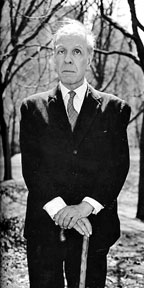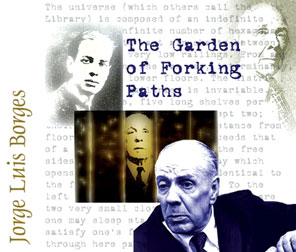|
Jorge Luis Borges:
One of the most influential and innovative writers of the Latin
American Boom

 |
|
Jorge Luis Borges |
A prolific writer of many and mixed genres, Borges is recognized as
one of the most influential and innovative Latin American authors of the
twentieth century. His experiments with the intermingling of fantasy and
realistic detail prefaced the realist style of writing practiced by many
major Latin American authors. The works of many of these, such as
Gabriel Garcia Marquez and Julio Cortázar have been reviewed in previous
weeks. The latter writer referred to Borges as 'the leading figure of
our fantastic literature'. His insights have established him as one of
modern literature's most philosophically accomplished authors.
Although Borges has largely been recognized for the stylistic
originality of his essays and the metaphysical experimentation of his
short fiction, critics have also frequently praised his poetic works for
their formal precision and mellifluous tone.
Borges is best known for his erudite short stories, which blend
fantasy and realism to address complex philosophical problems. Involving
such thematic motifs as time, infinity, identity, and memory, his
stories combine elements of fiction and personal essay in hybrid forms
that resist classification.
Earlier in his career Borges wrote poetry and criticism almost
exclusively. At this time he associated with the Ultraístas, an
avant-garde literary group whose works fuse elements of Dadaism,
Imagism, and German Expressionism. To summarize contemporary critical
thought concerning Borges's poetry, the Argentine's later poems are
among the most skilful and in the Spanish language. Strict in their
rules and sober in their imagery, they are gentle in tone, recollected
in tranquillity, elegiac, formal and symmetrical.
Although Borges is best known for his short stories, he wrote a
significant amount of poetry, which has gained increasing critical
attention. In his first collection, 'Fervor de Buenos Aires', he used
Ultraíst concepts to portray colourful individuals and events in Buenos
Aires.
His next volume of poetry, 'Luna de enfrente', contains confessional
and love poetry. Both collections are thought to anticipate Borges's
later concerns with such topics as time, memory, and the architectural
features of Buenos Aires. 'Cuaderno San Martin' consists chiefly of
tributes to deceased poets, among them Francisco López Merino, Borges's
friend and associate, who committed suicide.
 |
|
Ficciones |
In his later poetry, Borges adopted a neoclassic approach, availing
himself of the poetic elements discarded by the avant-garde poets.
Moreover, he applied some of the principles used in his prose, such as
intertexual reference and the articulation of the whole. 'El hacedor'
(1960; Dreamtigers), a collection of brief poems, quotations, and
parables, uses the tiger as an ambivalent symbol of unnatural evil and
natural change. Dreamtigers has been heralded as one of the literary
masterpieces of the twentieth century by Mortimer J. Adler, editor of
Great Books of the Western World.
It was also acknowledged by Borges himself as his most personal work.
Composed of poems, parables, and stories, sketches and apocryphal
quotations, Dreamtigers would appear at first glance to be a sampler
(albeit a dazzling one) of the master's work. Upon closer examination,
however, the reader discovers the book to be a subtly and organically
unified self-revelation. Dreamtigers explores the mysterious territory
that lies between the dreams of the creative artist and the "real"
world.
The central vision of the work is that of a recluse in the
"enveloping serenity " of a library, looking ahead to the time when he
will have disappeared but in the timeless world of his books will
continue his dialogue with the immortals of the past (Homer, Don
Quixote, Shakespeare). Like Homer, the maker of these dreams is
afflicted with failing sight. Still, he dreams of tigers real and
imagined and reflects upon of a life that, above all, has been intensely
introspective, a life of calm self-possession and absorption in the
world of the imagination.
At the same time he is keenly aware of that other Borges, the public
figure about whom he reads with mixed emotions. "It's the other one,
it's Borges, that things happen to." In the title poem of 'Elogio de la
sombra' (1969 In Praise of Darkness) Borges proposed the paradoxical
notion that old age and blindness may signify deep happiness because of
the imminence of death. Dualities involving physical blindness and
spiritual sight also pervade 'El oro de los tigres' (1972 The Gold of
Tigers.)
Borges's writing is also steeped by influences and informed by
scholarship of Christian, Buddhist, Islamic, and Jewish faiths,
including mainline religious figures, heretics, and mystics. Heretical
forms of Christianity, for example, make a dominant appearance in the
short story 'Three Versions of Judas', in which a maverick theologian
decides that Judas Iscariot was the Messiah, as the greatest sacrifice
for God would not be to sacrifice his son's body, but his son's soul.
This curious inversion of mainstream Christian concepts of redemption is
characteristic of Borges' approach to theology in his literature.
Due to the praise of "The Garden of Forking Paths", the term "Borgesian"
has been coined to fulfill the meaning of non-linearity within the world
of digital media.
 |
|
The Garden of forking
paths |
The 1941 short story presents the idea that there are forking paths
through networks of time - none of which is the same, all of which are
equal.
In regards to the organization of information, Borges imagines "a
labyrinth that folds back upon itself in infinite regression" making the
reader of his 'Garden of Forking Paths' "become aware of all the
possible choices we might make."
Borges used the story to show his philosophy of life. The "forking
paths" has a recurring circular labyrinth with separate "branches" to
represent the user's choices and decisions in their lives that
ultimately lead to different endings. Borges saw man's search for
meaning in a seemingly infinite universe as fruitless and instead uses
the maze as a riddle for time, not space.
The story is still used today, mostly in new media art. In this form
of art, the user has control over the piece and the result by selecting
different branches that lead the user down different paths.
I feel that this column does not do justice to Borges, who is the
most complex author I have reviewed so far in these columns. This is
especially the case given that he can be described as one of the
patriarchs of the Boom genre of literature.
However, Borges offers through the perfection of his language, the
extent of his knowledge, the universalism of his ideas, the originality
of his fictions and the beauty of his poetry a veritable feast for the
mind.
|

